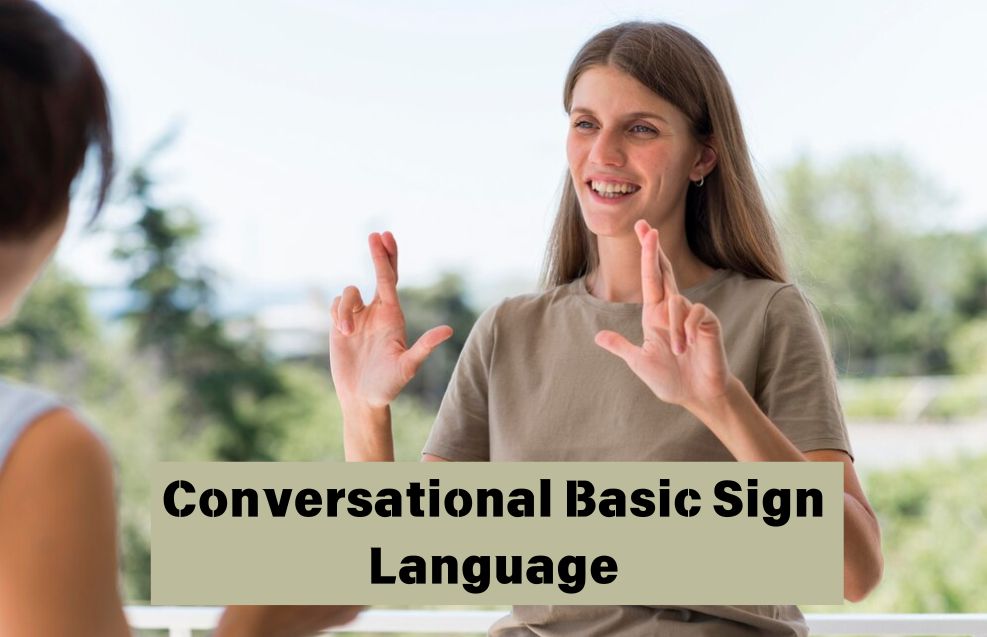Conversational basic sign language is an essential skill that fosters inclusivity and opens up communication between people who are deaf or hard of hearing and those who do not use sign language as their primary mode of communication. As the world becomes more interconnected and accessible, conversational basic sign language is being recognized as a critical tool in bridging communication gaps. This blog will explore what conversational basic sign language entails, its significance, usage statistics, and its growing role in everyday conversations.
Understanding Conversational Basic Sign Language
Conversational basic sign language is a simplified form of sign language, designed for quick communication in everyday settings. Unlike full sign language systems that have their own complex grammar and syntax, conversational basic sign language focuses on a small set of essential signs that are easy to learn and use. It enables individuals to communicate effectively with people who rely on sign language but might not be fluent in more intricate signing systems.
In many cultures, sign language is not only a way for deaf individuals to communicate but also a way to share culture, identity, and expression. Conversational basic sign language allows people without formal training in sign language to interact in a meaningful way with those who are deaf or hard of hearing. Learning just a few key signs, such as greetings, requests, or common expressions, can dramatically improve communication and create a more inclusive environment for everyone.
Why Is Conversational Basic Sign Language Important?
Incorporating this sign language into everyday interactions can have profound benefits. Here are a few reasons why it is so significant:
- Enhancing Inclusivity: This sign language ensures that individuals who are deaf or hard of hearing do not feel isolated or left out in group conversations. It fosters a more inclusive society by promoting accessibility.
- Improving Communication: Even for people who do not use sign language regularly, knowing this sign language helps create smoother and more effective communication when needed.
- Building Community: The use of this basic sign language in public spaces and social gatherings can lead to stronger connections and mutual understanding between people of different backgrounds.
- Boosting Confidence: People who learn this basic sign language gain the confidence to engage with the deaf community without feeling apprehensive or misunderstood.
- Emergency Situations: Knowing this basic sign language can be particularly useful in emergency situations when verbal communication might be challenging or impossible.
The Role of Conversational Basic Sign Language in Various Regions
Usage statistics and regional data reflect the increasing importance of conversational basic sign language across the globe. According to the World Health Organization, approximately 5% of the world’s population lives with hearing loss. In many countries, there is an effort to increase awareness of the need for sign language education. Let’s take a look at some key regions where conversational basic sign language is gaining traction:
United States
In the United States, this sign language has been widely adopted in schools, workplaces, and public spaces. According to the National Institute on Deafness and Other Communication Disorders (NIDCD), about 1 in 4 people in the U.S. experience some form of hearing loss. This has led to an increase in demand for basic sign language skills across communities.
For example, several school districts in the U.S. now offer sign language courses to help students engage with their peers who are deaf or hard of hearing. Moreover, businesses and healthcare facilities are incorporating basic sign language training to provide more accessible customer service. According to a survey by the Hearing Loss Association of America, 65% of deaf individuals believe that society should make more effort to teach this sign language in public spaces.
United Kingdom
In the United Kingdom, conversational basic sign language is also gaining popularity. The British Deaf Association reports that approximately 12 million people in the UK are living with hearing loss. As a result, initiatives like the “Sign for Sign” campaign have been created to encourage the public to learn basic sign language. Many workplaces, especially in healthcare and retail, have adopted conversational basic sign language to improve interactions with customers and clients.
Furthermore, many local government offices have introduced sign language as part of their training for customer service staff. This is a direct response to the increasing awareness of the need for better accessibility, with 1 in 6 people in the UK reporting hearing difficulties.
Australia
Australia has seen similar trends with this sign language being incorporated into schools, businesses, and government services. The Australian Sign Language community, also known as Auslan, has raised awareness of the importance of sign language in promoting equality. In Australia, approximately 3.6 million people live with hearing loss, and the government has put measures in place to train public servants in basic sign language.
In many cities across Australia, public events and social groups are offering introductory sign language courses, making conversational basic sign language more accessible. For instance, Sydney’s “Sign Language Social” meets regularly to promote conversational sign language among both hearing and non-hearing individuals. These events are helping to break down communication barriers and raise awareness about the needs of the deaf community.
Learning Conversational Basic Sign Language: How to Get Started
Whether you’re looking to improve your communication skills in everyday situations or aiming to engage with the deaf community, learning conversational basic sign language is an achievable and rewarding endeavor. Here are a few ways to start learning:
- Enroll in a Class: Many community centers, colleges, and online platforms offer basic sign language classes. These classes typically focus on learning essential signs and basic grammar to facilitate simple conversations.
- Use Apps and Online Resources: There are several apps available that teach this sign language. For instance, apps like “SignSchool” and “The ASL App” offer beginner-friendly lessons that can help users learn at their own pace.
- Practice with a Partner: Once you’ve learned a few basic signs, try practicing with someone who is either deaf or familiar with sign language. Practicing with a native user of the language will help you gain confidence and improve your understanding of non-verbal cues, such as facial expressions and body language.
- Join Community Events: Many cities offer regular meetups and workshops focused on conversational basic sign language. These events are great opportunities to practice in real-life settings, meet other learners, and improve your skills.
- Learn Online: For those with busy schedules, there are numerous online platforms and YouTube channels that offer free tutorials for learning basic signs.
Read Also : What Is the Ad Hoc Meaning and How Does It Apply in Real Life?
The Future of Conversational Basic Sign Language
As the importance of inclusivity continues to grow, the adoption of this sign language is expected to expand further. Institutions, including schools, universities, and workplaces, are increasingly seeing the value of offering sign language education to students and staff. Not only does this improve accessibility, but it also strengthens the social fabric of communities by creating spaces where all individuals can communicate freely.
In the coming years, we expect to see more widespread government initiatives aimed at incorporating the sign language into public policy and services. This will likely lead to better support systems for those who are deaf or hard of hearing and improve accessibility for people with disabilities in general.
Brands and Organizations Promoting Conversational Basic Sign Language
Some notable brands and organizations are leading the charge in promoting conversational basic sign language. For example, Coca-Cola and Google have partnered with the National Association of the Deaf (NAD) to support sign language education. Additionally, tech companies such as Microsoft have implemented sign language in their training programs to ensure inclusivity in the workplace.
Furthermore, educational platforms like Skillshare and Udemy are offering affordable courses to teach conversational sign language. These platforms are opening up new opportunities for people worldwide to learn this invaluable skill and apply it in daily interactions.
Conclusion
Conversational basic sign language is more than just a set of hand gestures – it’s a powerful tool that fosters inclusion, breaks down communication barriers, and enhances relationships between individuals from diverse backgrounds. As awareness grows, more people are embracing the idea of learning sign language, making it an essential skill for building a more accessible and understanding society.
The significance of conversational basic sign language will only continue to grow as more regions around the world promote its learning. Whether you’re in the United States, the UK, Australia, or any other country, there are opportunities to learn and practice this skill. By doing so, you not only improve your communication but also contribute to a culture of empathy and respect for the deaf and hard-of-hearing community.
As the adoption of conversational basic sign language increases, we are likely to see a more inclusive world where everyone can communicate effortlessly, regardless of their hearing ability.

